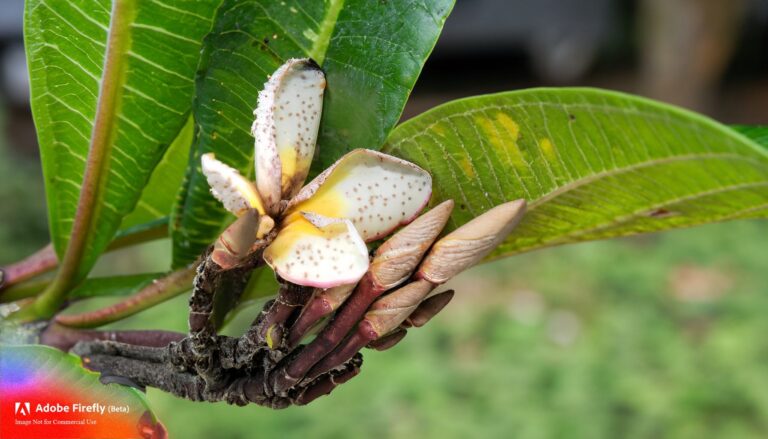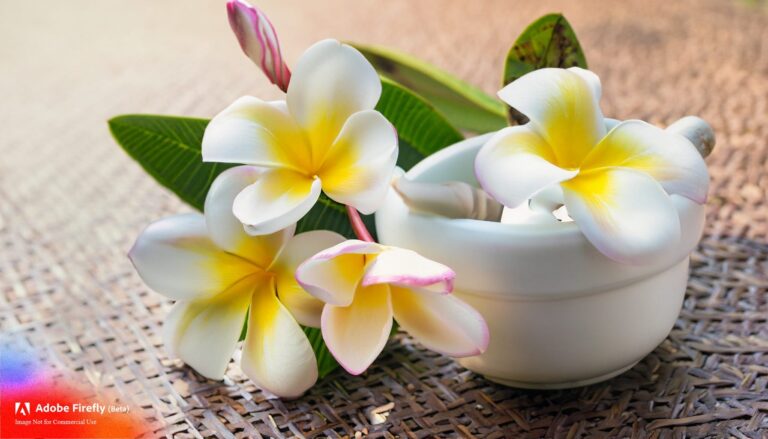
When planting frangipani trees, it’s important to consider their mature size and give them adequate spacing to grow and develop properly. The spacing between frangipani trees will depend on a few factors, including the variety of frangipani, the available space in your garden, and the desired visual effect.
As a general guideline, here are some spacing recommendations:
- Large frangipani varieties: For larger frangipani trees with a mature spread of around 10 to 15 feet (3 to 4.5 meters), it is recommended to space them at least 15 to 20 feet (4.5 to 6 meters) apart. This allows ample room for the trees to expand their canopy and avoids overcrowding.
- Medium-sized frangipani varieties: For medium-sized frangipani trees with a mature spread of around 6 to 10 feet (1.8 to 3 meters), a spacing of approximately 10 to 15 feet (3 to 4.5 meters) between them is appropriate. This ensures enough space for each tree to grow and prevents them from competing for resources.
- Small frangipani varieties: Smaller frangipani varieties, such as dwarf or compact cultivars, generally have a mature spread of around 3 to 6 feet (1 to 1.8 meters). For these smaller varieties, you can space them approximately 6 to 10 feet (1.8 to 3 meters) apart to allow for their growth and to showcase their individual beauty.
These spacing recommendations are general guidelines and can be adjusted depending on the specific characteristics of the frangipani trees and your landscape design preferences. It’s also important to consider other factors, such as proximity to structures, access to sunlight, and proper air circulation, when determining the spacing between frangipani trees.
- Individual Trees: If you’re planting frangipani trees as standalone specimens, give each tree ample space to develop a full canopy and root system. Generally, spacing them at least 10 to 15 feet (3 to 4.5 meters) apart should provide enough room for the mature trees to spread their branches without overcrowding.
- A hedge or Border Planting: You can space them slightly closer for a hedge or border effect where you want multiple frangipani trees to grow together. Aim for a spacing of around 6 to 8 feet (1.8 to 2.4 meters) between the trees. This will allow them to create a cohesive screen or boundary while allowing adequate room for each tree to grow and thrive.
- Consider Canopy Size: Consider the expected mature size of the frangipani tree’s canopy when determining the spacing. Frangipani trees can spread 10 to 20 feet (3 to 6 meters), depending on the variety. Providing enough space between trees will allow each to develop a balanced and attractive shape without overlapping with neighboring trees.
- Site and Soil Conditions: Spacing can also be influenced by site and soil conditions. If your soil is particularly rich or fertile, frangipani trees may grow larger and require more space between them. Consider the available sunlight, drainage, and other environmental factors to ensure adequate growing conditions for each tree.
Frangipani Tree: Cutting, Growing, Propagation, and More
Cutting and Pruning:
- Pruning frangipani trees is typically done during their dormant period, which is usually in winter. This is when the tree sheds its leaves. Pruning helps maintain the tree’s shape, remove dead or damaged branches, and promote airflow and light penetration.
- When cutting branches, use clean and sharp tools to make clean cuts at a slight angle just above a leaf node or bud.
- Avoid heavy pruning or cutting back more than one-third of the tree’s canopy at a time, as this can stress the plant.
Growing Conditions:
- Frangipani trees thrive in warm, tropical climates. They require full sun to bloom abundantly and need at least six hours of direct sunlight per day.
- They prefer well-draining soil, such as sandy or loamy soil. Good drainage is crucial to prevent root rot.
- Frangipani trees are drought-tolerant once established, but they still require regular watering during their active growth period. Water deeply, allowing the soil to dry out between waterings.
Propagation:
- Frangipani trees can be propagated through various methods:
- Stem Cuttings: Take a 12-18 inch (30-45 cm) cutting from a healthy, mature branch. Allow the cutting to dry and form a callus for a few days, then plant it in well-draining soil. Keep the soil lightly moist until roots develop.
- Air Layering: Select a healthy branch and make a small upward cut through the bark. Apply rooting hormone to the exposed area, wrap it with moist sphagnum moss or a rooting medium, and cover it with plastic. Roots will form in a few months. Once roots develop, cut the branch below the rooted area and plant it.
- Seeds: Collect seeds from mature pods and allow them to dry for a few days. Sow the seeds in a well-draining soil mix and keep them warm and moist. Germination can take several weeks to months.
Blooming and Care:
- Frangipani trees typically bloom during the summer months, producing clusters of fragrant, colorful flowers in various shades of pink, white, yellow, or red.
- Fertilize frangipani trees during the growing season with a balanced, slow-release fertilizer. Avoid excessive nitrogen, as it can promote foliage growth at the expense of flowers.
- Protect the tree from frost or cold temperatures by providing insulation or moving it indoors if needed.
It’s important to note that some frangipani varieties may be toxic to pets, so ensure they are planted in a safe location if you have animals.
With proper care, frangipani trees can provide years of beauty and fragrance to your garden or landscape.
Summary
Remember that these are general guidelines, and the specific spacing between frangipani trees may vary depending on the variety, local climate, and your preferences. Providing sufficient space will allow each tree to establish a strong root system, access adequate sunlight, and showcase its unique beauty without competing with nearby trees.






